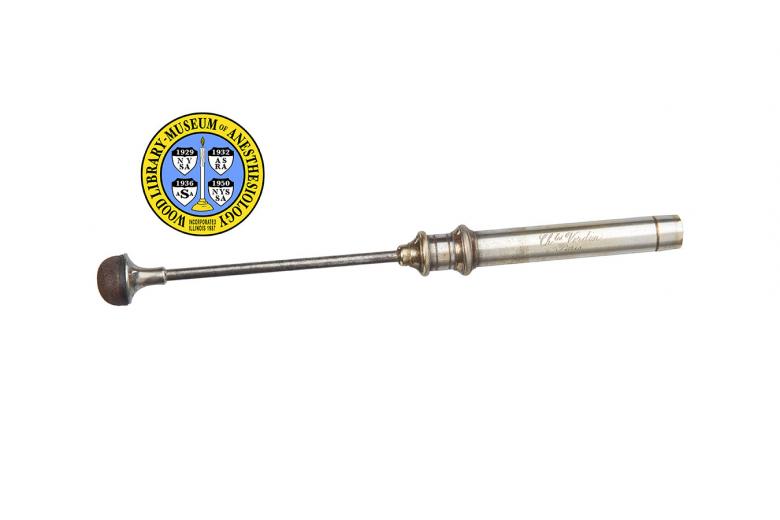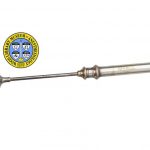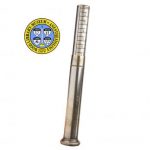Bloch Sphygmometer
Not much larger than the average retractable pen with a grip, this sphygmomanometer could easily fit in a physician’s pocket, making it a popular instrument in Europe for measuring blood pressure from the 1890s through the 1920s. The original design was introduced around 1888 by the French physician Adolphe-Moïse Bloch (1842-1920). It featured a circular dial with a rotating needle. The French manufacturer Charles Verdin simplified it by replacing the bulky dial with a telescoping scale. That model is seen here.
To use the device the physician would rest his finger over the patient’s radial pulse, place the padded tip of the device onto his finger, and then, applying downward force on the rod, push his finger into the patient’s wrist. This caused the scale to rise from the interior of the rod. He continued this pressure until he no longer felt the patient’s pulse. At this point the physician would note how far the telescoping bar had emerged from the rod. The scale is graduated in grams from 100 to 1200. Later versions were marked in millimeters of mercury as well. After researchers demonstrated that readings from these types of sphygmomanometers were consistently unreliable, their use fell out of favor.
Catalog Record: Bloch Sphygmometer
Access Key: akhx
Accession No.: 2001-05-02-1 B
Title: [Sphygmomètre de Bloch, modifié par Verdin.]
Author: Bloch, Adolphe-Moïse, 1842-1920.
Corporate Author: Verdin, Charles.
Title variation: Alt Title
Title: Sphygmomètre de Ch. Verdin.
Title variation: Alt Title
Title: Bloch sphygmomanometer, modified by Verdin.
Title variation: Alt Title
Title: Sphygmomètre Bloch, modèle Verdin.
Title variation: Alt Title
Title: Sphygmomètre Ch. Verdin, méthode du Dr Bloch.
Title variation: Alt Title
Title: Sphygmomètre modifié Charles Verdin, méthod du Dr Bloch.
Title variation: Alt Title
Title: Sphygmomètre de Bloch-Verdin.
Title variation: Alt Title
Title: Bloch-Verdin sphygmomanometer.
Title variation: Alt Title
Title: Bloch Verdin sphygmometer.
Title variation: Alt Title
Title: Bloch sphygmometer.
Publisher: Paris : Ch. Verdin, [1888-1902].
Physical Descript: 1 sphygmomanometer : metals, rubber, cork ; 15.5 x 1.5 cm.
Subject: Blood Pressure Determination – instrumentation.
Subject: Blood Pressure Monitors.
Subject: Sphygmomanometers.
Note Type: General
Notes: The sphygmomanometer made by Charles Verdin was inspired by one designed by
physician A.M. Bloch. The early date (1888) in the date range for the
possible year of manufacture is based on the year that Dr. Bloch first
described his “sphygmomètre” (1888). The end date is an estimate based on the
year that Bloch described his first modification (1896) and complained that
his work was not properly recognized by Verdin, and also on a 1902
publication by Vaschide and Lahy in which they discuss the Bloch
sphygmomanometer and Verdin’s modification, including a sample
sphygmomanometer, and provide two illustrations supplied by Verdin, which
indicate that the sphygmomanometers were being manufactured with the
recognition of Bloch. The date range could change if documentation indicates
the range should be corrected.
Note Type: General
Notes: The title is based on the name of the object in the earliest publication in
which the object is described as a product of the work of both Bloch and
Verdin (Binet & Vaschide, 1896). Images provided to a publisher for a 1889
article, and the 1890 catalog of Verdin, identify this sphygmomanmeter as the
“Sphygmomètre de Verdin.” In 1896, Bloch described his first modification
and complained that his work was not properly recognized by Verdin. A 1902
publication by Vaschide and Lahy describes a sample sphygmomanometer supplied
by Verdin, and contains two illustrations (also supplied by Verdin) depicting
this sphygmomanometer. All are marked in a way that indicates that the
sphygmomanometers were being manufactured with the recognition of Bloch. The
sphygmomanometer is marked, “Sphygmomètre modifié Charles Verdin, méthod du
Dr Bloch” (pages 609-611). The caption of the first illustration contains the
text, “Sphygmométre Ch. Verdin, méthode du Dr Bloch,” and in the caption of
the second illustration is, “Sphygmomètre Bloch, modèle Verdin.” Later
manifestations of this version the of the Bloch-Verdin sphygmomanometer,
manufactured by Verdin, and marked “method of Bloch” [in French] are held by
the Museum of Historical Medical Artifacts and the Neuroscience Museum of the
Département des Neurosciences Fondamentales, Université de Genève.
Note Type: Citation
Notes: La base Léonore. Archives Nationales website. https://www.culture.gouv.
fr/documentation/leonore/leonore.htm. Accessed July 18, 2013.
Note Type: Citation
Notes: Binet A, Vaschide N. Influence du travail intellectuel, des emotions … sur
pression du sang. Annee Psychol. 1896;3:128.
Note Type: Citation
Notes: Bloch AM. Note sur un perfectionnement apporté a mon sphygmomètre. C R
Seances Soc Biol Fil. July, 1896;3, of series 10:745-746.
Note Type: Citation
Notes: Bloch AM. Nouveau modèle de mon sphygmomètre. C R Seances Soc Biol Fil. July,
1904;2:32-33.
Note Type: Citation
Notes: Bloch AM. Nouveau sphygmomètre. C R Seances Soc Biol Fil. January, 1888;5, of
series 8:84-86.
Note Type: Citation
Notes: Catalogue des Instruments de Précisions Construits par Charles Verdin. Paris:
Charles Verdin; [1888-1890]:62-63.
Note Type: Citation
Notes: Catalogue des Instruments de Précision pour la physiologie et la médecine
construits par Charles Verdin. Paris: Charles Verdin; November, 1890:57.
Note Type: Citation
Notes: Catalogue des Instruments de Précisions Construits par Charles Verdin. Paris:
J. Mersch; [1895-1897]:91-95.
Note Type: Citation
Notes: Debove GM, Achard C. Examen du pouls. Manuel de Diagnostic Mèdical. Paris: J.
Rueff; 1900:156-159.
Note Type: Citation
Notes: Huchard H. Traité Clinique des Maladies du Cœur et de L’Aorte. Paris: Octave
Doin; 1899:31-36.
Note Type: Citation
Notes: Lawrence C. Physiological apparatus in the Wellcome Museum. 3. Early
sphygmomanometers. Med Hist. 1979;23(4):474–478.
Note Type: Citation
Notes: La médecine a l’exposition de 1889. Progrès Médical. 1890;11(4):74-75.
Note Type: Citation
Notes: Oliver G. Pulse-pressure: a clinical study. Practitioner. May, 1893;50(5):333
Note Type: Citation
Notes: Vaschide N, Lahy JM. La technique de la measure de la pression sanguine
particulièrement chez l’homme. Arch Générales Med. 1902;8, part 2:606-611.
Note Type: Physical Description
Notes: A long and thin cylindrical, metallic device with a rounded pad of cork at
the tip; The main body of the device measures approximately 8.5 cm, with a
diameter of approximately 1 cm; A finger grip on the main body has a diameter
of 1.4 cm; The padded tip sits on a thin metallic bar that measures
approximately, 6 cm in length and .3 cm in diameter; This bar partially
retracts into the main body of the device when pressure is applied downward,
toward the padded tip; When no pressure is being applied a graduated bar on
the other end of the main body is not visible; This bar telescopes in and out
of the other end of the device in accordance with the amount of pressure
being applied; The bar is graduated from 100 to 1200 grams; Specifically, the
first visible graduation mark is, “100 GRAMMES”; Then graduation marks are
numbered with 2, 3, 4, 5, 6, 7, 8, 9, 10, 11, and 12; Between the numbered
marks are shorter marks indicating 50 grams; The main body of the device is
engraved with “Ch” followed by “les” in super script, and then “Verdin” [new
line] “Paris”.
Note Type: Reproduction
Notes: Photographed by Mr. Steve Donisch on January 16, 2013.
Note Type: Historical
Notes: Not much larger than the average retractable pen with a grip, this
sphygmomanometer could easily fit in a physician’s pocket, making it a
popular instrument in Europe for measuring blood pressure from the 1890s to
1920s.
This type of sphygmomanometer was originally designed around 1888 by French
physician Adolphe-Moïse Bloch (1842-1920) with a rotating needle and circular
dial at the end. The manufacturer Charles Verdin simplified it by replacing
the bulky dial with a telescoping function.
To use the device the physician would rest his finger over the patient’s
radial pulse, place the padded tip of the device onto his own finger, and
then, applying force with the sphygmomanometer only, push his finger into the
patient’s wrist until he no longer felt the patient’s pulse. At this point
the physician would note how far a graduated bar telescoped out the end of
the sphygmomanometer. An inner spring transferred the amount of pressure
being applied to an equivalent ejection of the graduated bar. This device is
graduated in grams from 100 to 1200. Later versions were marked in
millimeters of mercury as well.
After researchers demonstrated that readings from these types of
sphygmomanometers were consistently unreliable, their use fell out of favor.
When Verdin began selling his improved model it was marked with only his
company’s name. Many physicians then referred to the device as the Verdin
Sphygmomanometer. Bloch publicly expressed his disagreement and sometime
before 1903 Verdin began to manufacture his modified versions marked with the
text, “méthod du Dr Bloch.” Verdin’s version was modified by Dr J. Chéron in
the 1890s and further confused the names of the devices.
In 1896, Bloch described a modification which provided the sphygmomanometer
with a means of locking the graduated bar in place at the pressure that
occludes the radial artery (Bloch, 1896). The Wellcome Collection holds an
example of this later sphygmomanometer (Lawrence, 1979).
Note Type: Exhibition
Notes: Chosen for the WLM website (noted July 10, 2013).



